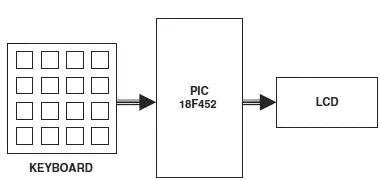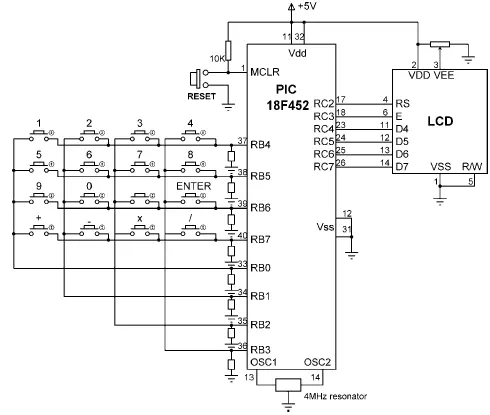The block diagram of the project is shown in Figure 6.45. The circuit diagram is given in Figure 6.46. A PIC18F452 microcontroller with a 4MHz resonator is used in the project. Columns of the keypad are connected to port pins RB0–RB3 and rows are connected to port pins RB4–RB7 via pull-down resistors. The LCD is connected to PORTC in default mode, as in Figure 6.39. An external reset button is also provided to reset the microcontroller should it be necessary.

Figure 6.45: Block diagram of the project

Figure 6.46: Circuit diagram of the project
The project PDL is shown in Figure 6.47. The program consist of two parts: function getkeypad and the main program. Function getkeypad receives a key from the keypad. Inside the main program the two numbers and the required operation are received from the keypad. The microcontroller performs the required operation and displays the result on the LCD.
Function getkeypad:
START
IF a key is pressed
Get the key code (0 to 15)
Return the key code
ENDIF
END
Main program:
START
Configure LCD
Wait 2 seconds
DO FOREVER
Display No1:
Read first number
Display No2:
Read second number
Display Op:
Read operation
Perform operation
Display result
Wait 5 seconds
ENDDO
END

Figure 6.47: Project PDL
The program listing for the program KEYPAD.C is given in Figure 6.48. Each key is given a numeric value as follows:
0 1 2 3
4 5 6 7
8 9 10 11
12 13 14 15
The program consists of a function called getkeypad , which reads the pressed keys, and the main program. Variable MyKey stores the key value (0 to 15) pressed, variables Op1 and Op2 store respectively the first and second numbers entered by the user. All these variables are cleared to zero at the beginning of the program. A while loop is then formed to read the first number and store in variable Op1 . This loop exits when the user presses the ENTER key. Similarly, the second number is read from the keyboard in a second while loop. Then the operation to be performed is read and stored in variable MyKey , and a switch statement is used to perform the required operation and store the result in variable Calc . The result is converted into a string array using function LongToStr . The leading blank characters are then removed as in Project 8. The program displays the result on the LCD, waits for five seconds, and then clears the screen and is ready for the next calculation. This process is repeated forever.
/**************************************************************
CALCULATOR WITH KEYPAD AND LCD
==============================
In this project a 4 x 4 keypad is connected to PORTB of a PIC18F452
microcontroller. Also an LCD is connected to PORTC. The project is a simple
calculator which can perform integer arithmetic.
The keys are organized as follows:
0 1 2 3
4 5 6 7
8 9 10 11
12 13 14 15
The keys are labeled as follows:
1 2 3 4
5 6 7 8
9 0 Enter
+ − * /
Author: Dogan Ibrahim
Date: July 2007
File: KEYPAD.C
**************************************************************/
#define MASK 0xF0
#define Enter 11
#define Plus 12
#define Minus 13
#define Multiply 14
#define Divide 15
//
// This function gets a key from the keypad
//
unsigned char getkeypad() {
unsigned char i, Key = 0;
PORTB = 0x01; // Start with column 1
while((PORTB MASK) == 0) // While no key pressed
{
PORTB = (PORTB << 1); // next column
Key++; // column number
if (Key == 4) {
PORTB = 0x01; // Back to column 1
Key = 0;
}
}
Delay_Ms(20); // Switch debounce
for(i = 0x10; i !=0; i <<= 1) // Find the key pressed
{
if ((PORTB i) != 0) break;
Key = Key + 4;
}
PORTB=0x0F;
while ((PORTB MASK) != 0); // Wait until key released
Delay_Ms(20); // Switch debounce
return (Key); // Return key number
}
//
// Start of MAIN program
//
void main() {
unsigned char MyKey, i,j,lcd[5],op[12];
unsigned long Calc, Op1, Op2;
TRISC = 0; // PORTC are outputs (LCD)
TRISB = 0xF0; // RB4-RB7 are inputs
//
// Configure LCD
//
Lcd_Init(&PORTC); // LCD is connected to PORTC
Lcd_Cmd(LCD_CLEAR);
Lcd_Out(1,1, "CALCULATOR"); // Display CALCULATOR
Delay_ms(2000); // Wait 2 seconds
Lcd_Cmd(LCD_CLEAR); // Clear display
//
// Program loop
//
for(;;) // Endless loop
{
MyKey = 0;
Op1 = 0;
Op2 = 0;
Lcd_Out(1,1, "No1: "); // Display No1:
while(1) // Get first no
{
MyKey = getkeypad();
if (MyKey == Enter) break; // If ENTER pressed
MyKey++;
if (MyKey == 10) MyKey = 0; // If 0 key pressed
Lcd_Chr_Cp(MyKey + '0');
Op1 = 10*Op1 + MyKey; // First number in Op1
}
Lcd_Out(2,1, "No2: "); // Display No2:
while(1) // Get second no
{
MyKey = getkeypad();
if (MyKey == Enter) break; // If ENTER pressed
MyKey++;
if (MyKey == 10) MyKey = 0; // If 0 key pressed
Lcd_Chr_Cp(MyKey + '0');
Op2 = 10*Op2 + MyKey; // Second number in Op2
}
Lcd_Cmd(LCD_CLEAR); // Clear LCD
Lcd_Out(1,1, "Op: "); // Display Op:
MyKey = getkeypad(); // Get operation
Lcd_Cmd(LCD_CLEAR);
Lcd_Out(1,1, "Res="); // Display Res=
switch(MyKey) // Perform the operation
Читать дальше















